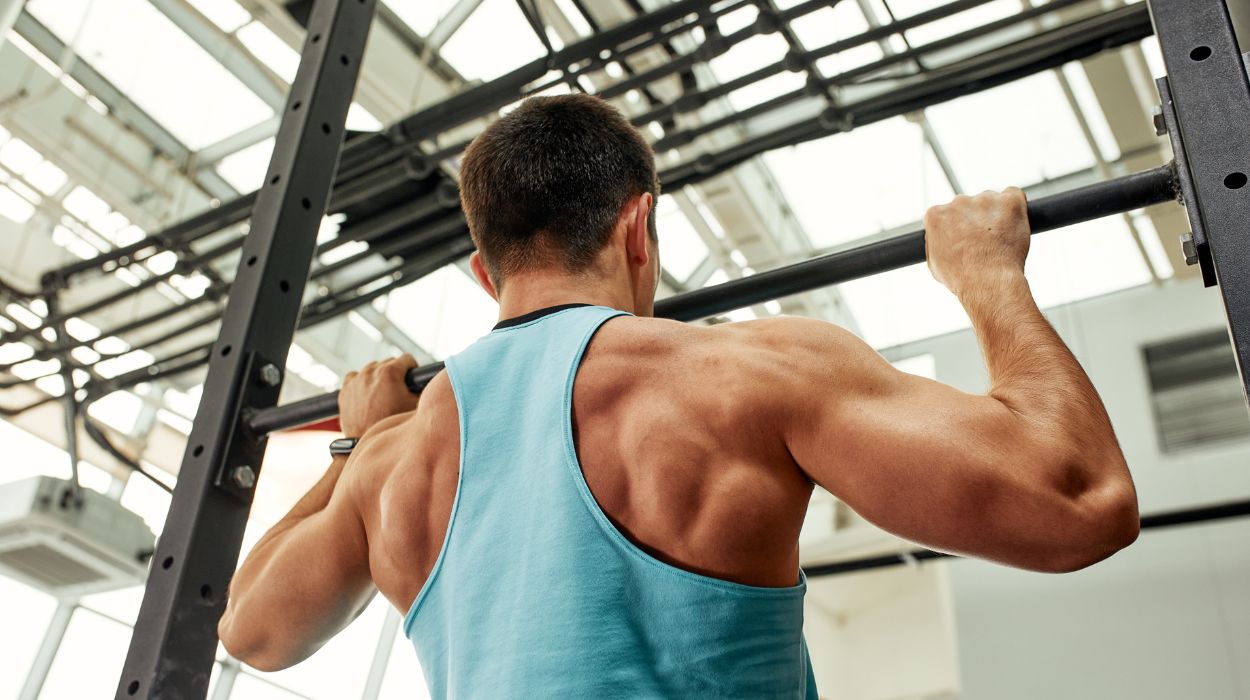
Whether you’re new to the gym or want to learn how to grow your shoulder muscles, you’ve come to the right place. The shoulder involves many muscle groups, and it can be challenging to know if you’re targeting all the right muscles.
This article provides a comprehensive approach to complete shoulder training so you can get the most out of your workout routine. We share 12 of the best shoulder workouts and explain the anatomy of the shoulder muscles. We also provide tips for shoulder stability so you can decrease your risk of injury and stay motivated.
12 Shoulder Stability Exercises For Muscular Shoulders
- Seated Dumbbell Shoulder Press
- Seated Dumbbell Lateral Raise
- Incline Bench Press
- Barbell Overhead Press
- Cable Face Pull
- Bent-over Dumbbell Reverse Fly
- Dumbbell Upright Row
- Standing Dumbbell Front Raise
- Bench Dumbbell Arnold Press
- Standing Kettlebell Single Arm Press
- Standing Dumbbell Shrugs
- Standing Dumbbell 3-Way Shoulder Raise
12 Shoulder Workouts For Mass In 2024
These shoulder workouts can be done in the comfort of your home with the right equipment or at your favorite gym. Here are 12 great shoulder workouts you can start incorporating into your shoulder strength training routine today:
Seated Dumbbell Shoulder Press
This is probably one of the most common exercises to target the muscles to build those boulder shoulders you’ve dreamed of. All you need is a pair of dumbbells. Follow these steps when performing this exercise.
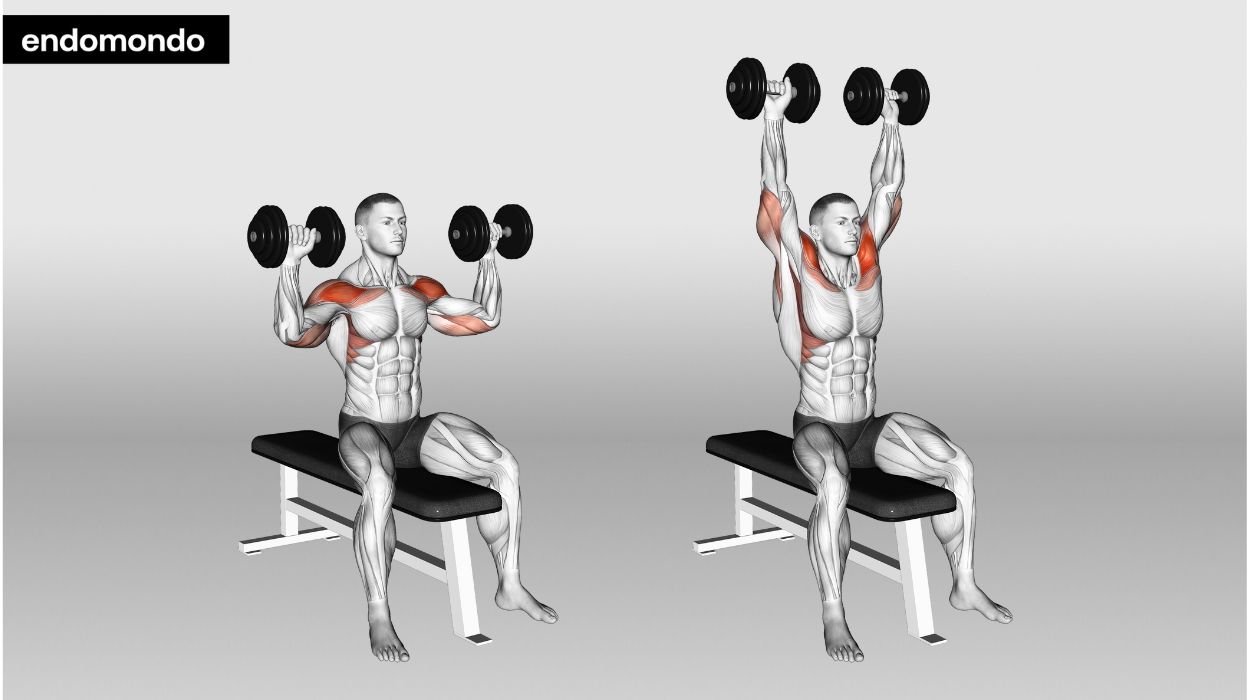
How to do:
- Grab two dumbbells and hold them with palms facing up as you sit on a bench.
- Starting position: Lift the elbows to shoulder height and make sure to keep your elbows bent.
- Press overhead with control and avoid locking your elbows. Pause briefly.
- Lower the weights back down and repeat the exercise for the desired reps.
Tips:
- Avoid jerking or using excess force.
- Don’t lock your elbows.
- You want to feel challenged but not where you strain your muscles.
- Maintain a straight posture and engage your abdominal muscles for stability.
Optimal sets and reps: 3-4 sets of 12-15 reps.
Seated Dumbbell Lateral Raise
This is another common shoulder exercise you can do. This dumbbell shoulder workout targets the lateral deltoid muscles. Let’s look at how you can do this.
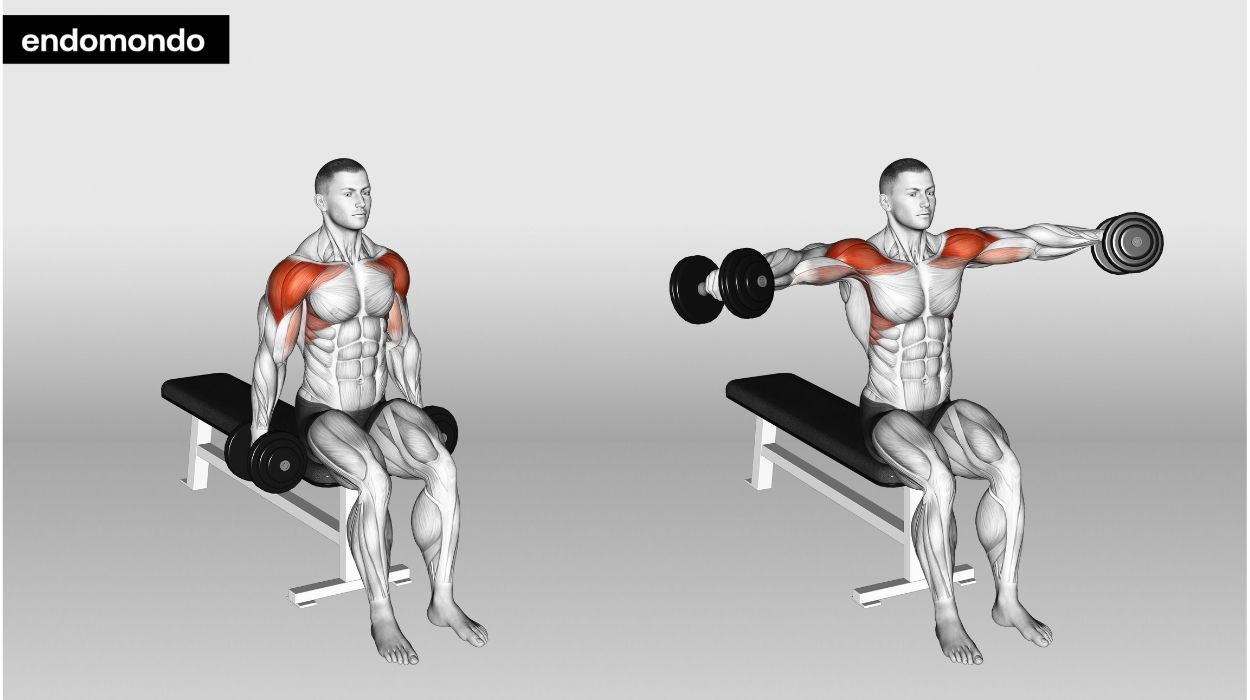
How to do:
- Sit on a bench With a dumbbell in each hand and palms facing upward.
- With controlled motion, lift both dumbbells simultaneously until your arms are parallel to the ground.
- Pause briefly at the top, contracting your lateral deltoid muscles.
- Slowly lower the weights back down.
Tips:
- Keep a slight bend in your elbows.
- Maintain a neutral spine.
- Avoid any jerking or swinging motions.
Optimal sets and reps: 3-4 sets of 10-12 reps.
Incline Bench Press (Barbell Or Dumbbell)
The Incline Bench Press is a great example of a compound shoulder exercise, meaning it targets multiple muscles at the same time. This shoulder training exercise specifically targets your shoulders, upper chest, and triceps. You can use a barbell or set of dumbbells for this.
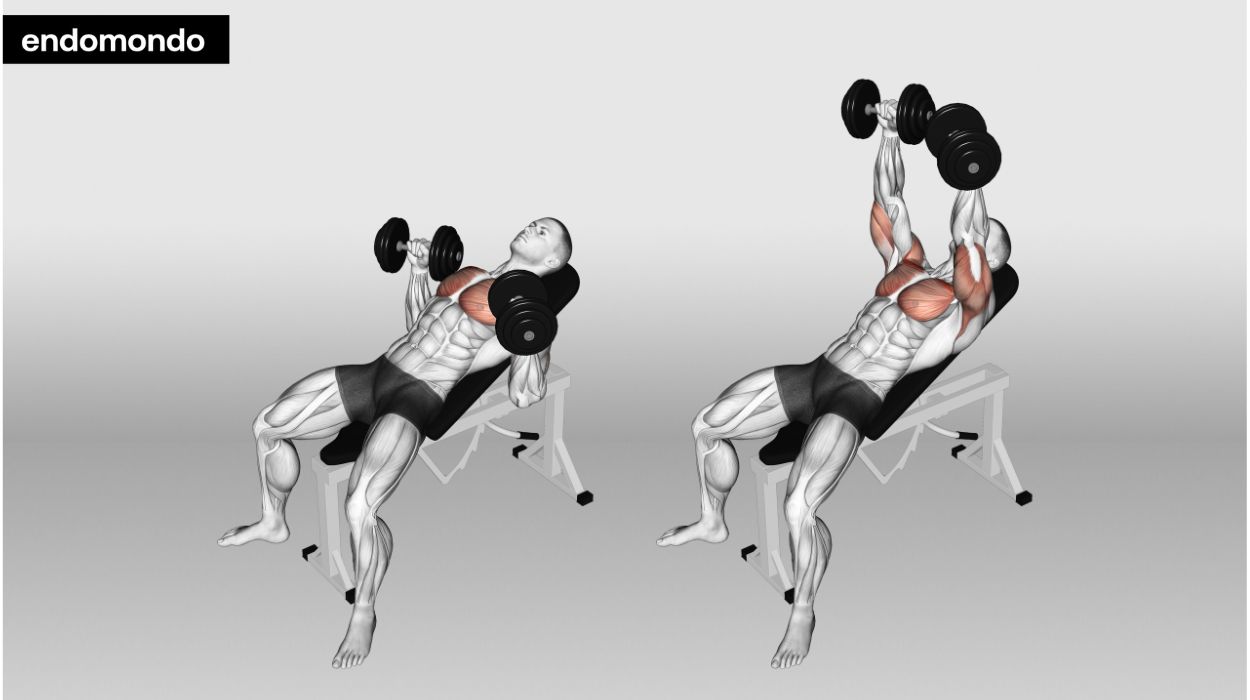
How to do:
- Set an adjustable bench to a 15-30 degree incline and lie on your back with your feet flat on the floor. Grip the dumbbell or barbell with an overhand grip.
- Position the barbell or dumbbells above your chest, with your elbows slightly bent and in line with your shoulders.
- Push the weight upwards, extending your arms fully without locking your elbows.
- Lower the weight back down to the start.
Tips:
- Make sure to keep a slight bend in your elbows when performing this exercise.
Optimal sets and reps: 3-4 sets of 8-10 reps.
Standing Barbell Overhead Press
This is also commonly referred to as a military press and focuses on your delts. Follow the steps below when performing this exercise.
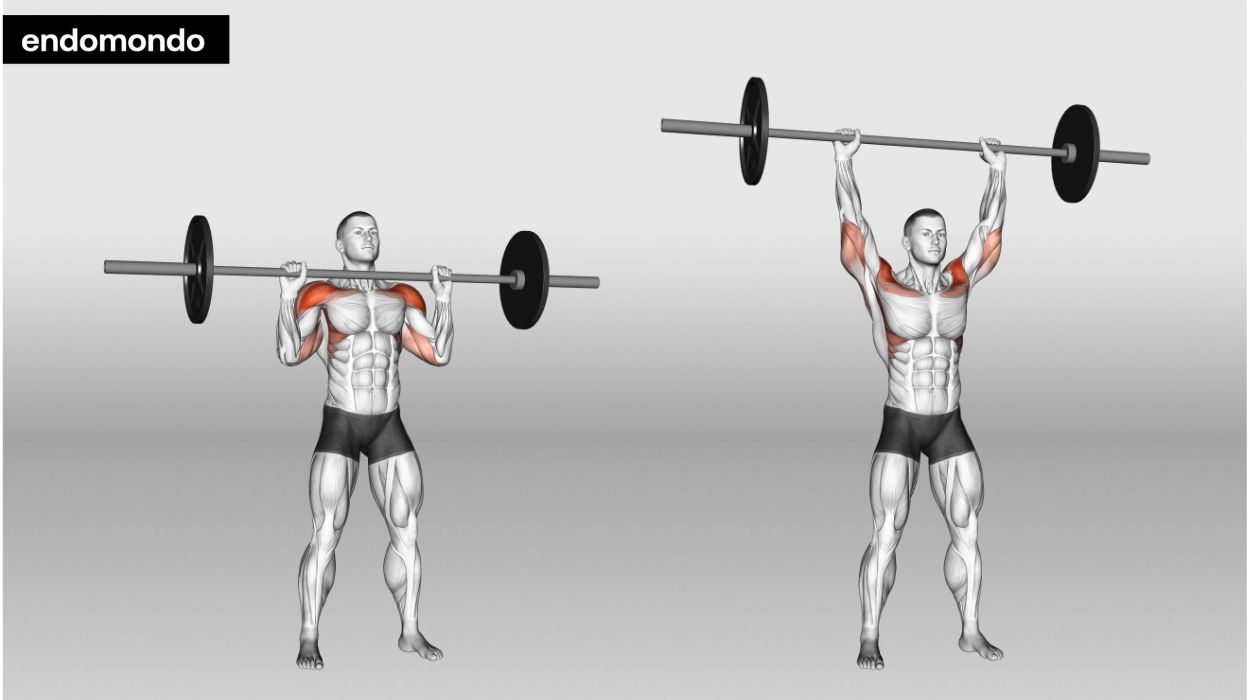
How to do:
- Start with your feet shoulder-width apart in a standing position. Grip the barbell overhand with your hands slightly wider than shoulder-width apart. It should be positioned at your collarbone level in front of you.
- Press the barbell overhead while extending your arms. Fully extend your elbows without locking them.
- Lower the barbell back down to collarbone level in a controlled manner. Keep tension in your shoulders to avoid letting the weight drop rapidly.
Tips:
- When lifting the barbell overhead, keep your core engaged and avoid leaning back.
Optimal sets and reps: 3-4 sets of 12-15 reps.
Standing Cable Face Pull
This exercise targets your rear delts and the muscles of the upper back. You can use a rope or a dual-handle attachment to do this exercise. Follow these steps when performing this exercise to get the most benefit.
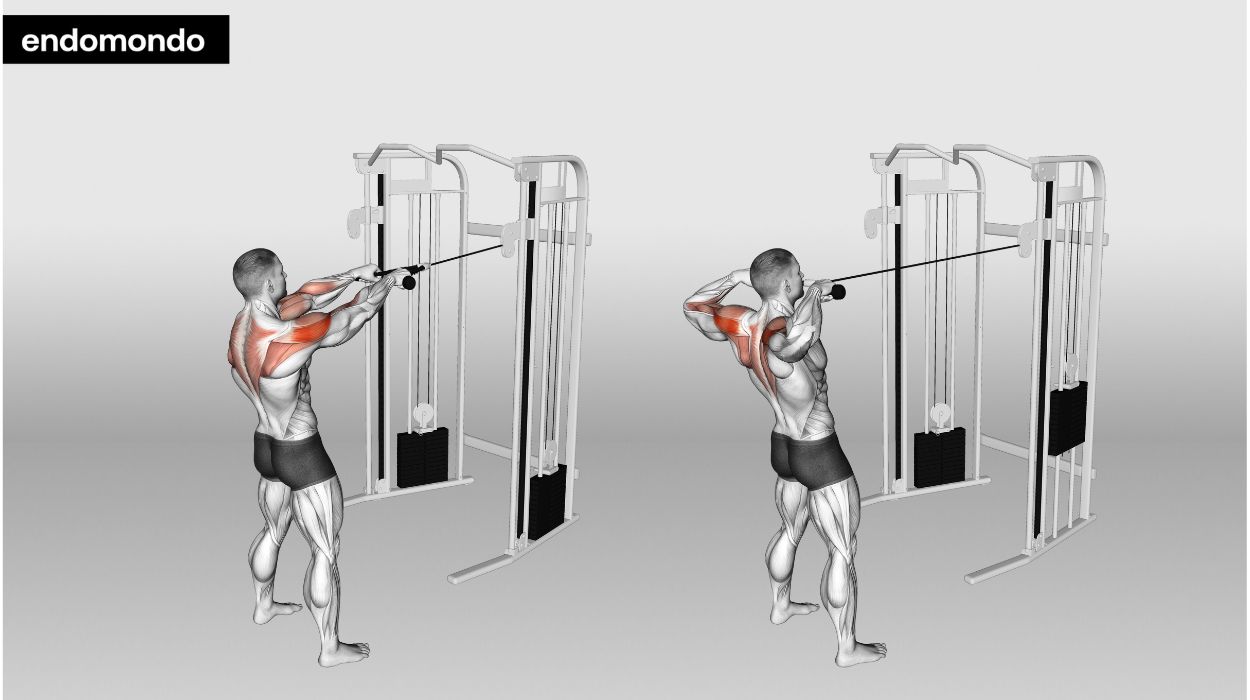
How to do:
- Attach a rope to the cable machine. Make sure to set the pulley to an upper level and stand facing the pulley machine.
- Grab the handles with an overhand grip and take a step back to create tension in the cable. Keep your knees slightly bent.
- Pull the handles towards your face increasing rotator cuff strength, and keep your upper arms parallel to the ground.
- As you pull the handles towards your face, make sure they pass just outside your ears.
- Gradually extend your arms, returning the handles to the starting position.
Tips:
- Make sure to position yourself with a stable stance, feet shoulder-width apart.
- When you pull the handles towards your face, squeeze your shoulder blades together and lead with your elbows.
- Avoid leaning back excessively and maintain a neutral spine
- When returning the cable, do it in a controlled way. Resist pulling your arms back too quickly.
Optimal sets and reps: 4 sets of 12-15 reps.
Bent-Over Dumbbell Reverse Fly
This next exercise targets the rear delts, as well as the upper back. Follow these steps to get the most out of your next shoulder workout.
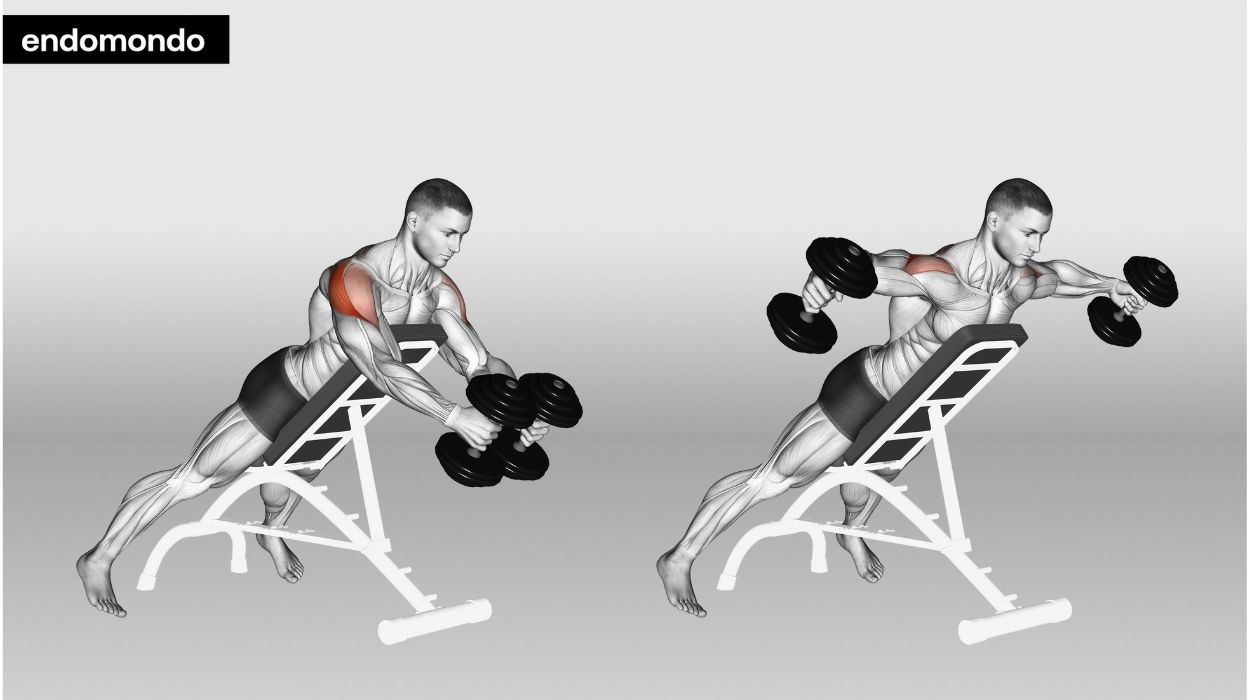
How to do:
- Stand with your feet shoulder-width apart, holding a dumbbell in both hands. Hinge at your hips and bend over to a 45-degree angle.
- Let the dumbbells hang directly beneath your shoulders with palms facing each other.
- With elbows slightly bent, lift the dumbbells out to the side, leading with your elbows.
- Lift the dumbbell until your arms are parallel to the ground or slightly higher. You should feel a contraction in your rear deltoid and upper back muscles.
- Lower the dumbbells back down and slightly bend your elbows to protect your shoulder joints.
Tips:
- Keep your back straight.
- Maintain a neutral spine to avoid putting stress on your lower back.
- Squeeze your shoulder blades together during the lift.
- Engage your core to help stabilize your torso.
Optimal sets and reps: 3 sets of 10-12 reps.
Dumbbell Upright Row
This is another dumbbell shoulder workout that targets your shoulder muscles. Follow these steps to do this exercise correctly.
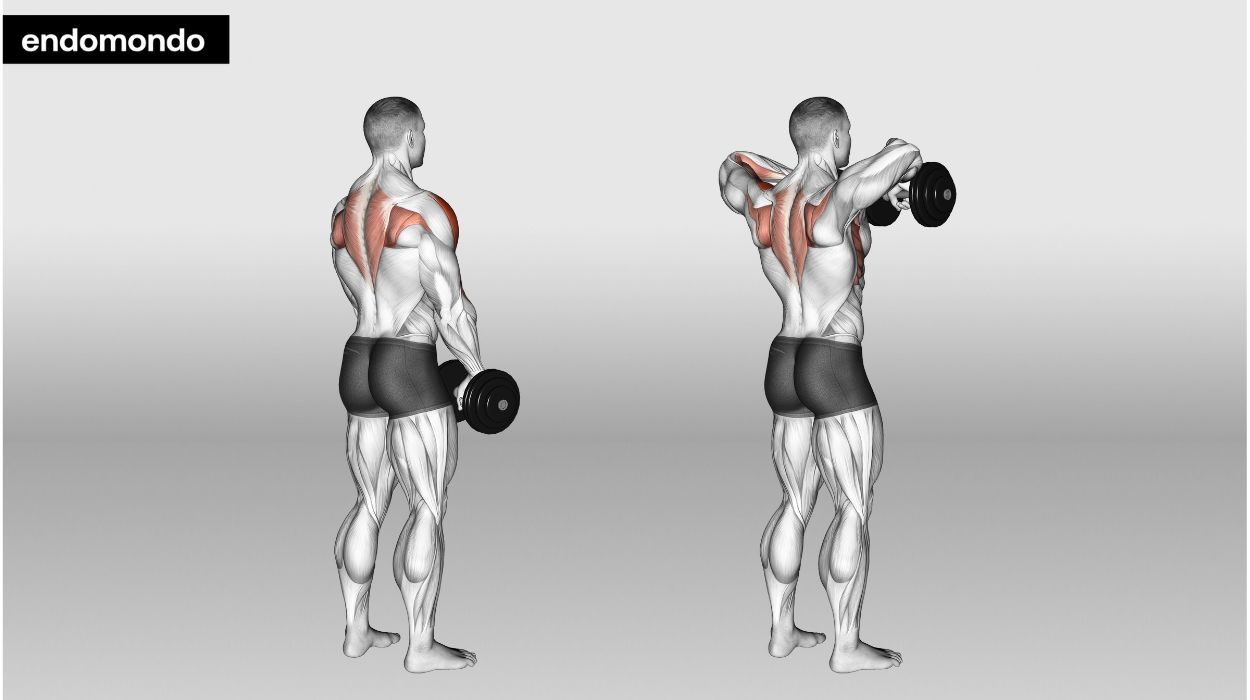
How to do:
- Hold a pair of dumbbells overhand in front of your thighs. Make sure your palms are facing your body.
- Engage your shoulder muscles and lift the weights vertically toward your chin.
- Continue lifting until your elbows reach shoulder height or slightly above.
- Lower the dumbbell down carefully to the starting position.
Tips:
- Make sure to stand with your feet shoulder-width apart.
- You want to focus on squeezing your shoulder muscles.
- Hold the position at the top and squeeze your shoulder muscles to ensure optimal. muscle contraction. This helps shoulder mobility.
Optimal sets and reps: 4 sets of 10 reps.
Standing Dumbbell Front Raise
This is another common shoulder workout involving dumbbells. You can also use a kettlebell to do this if equipment is limited. Follow the steps below when doing this exercise.
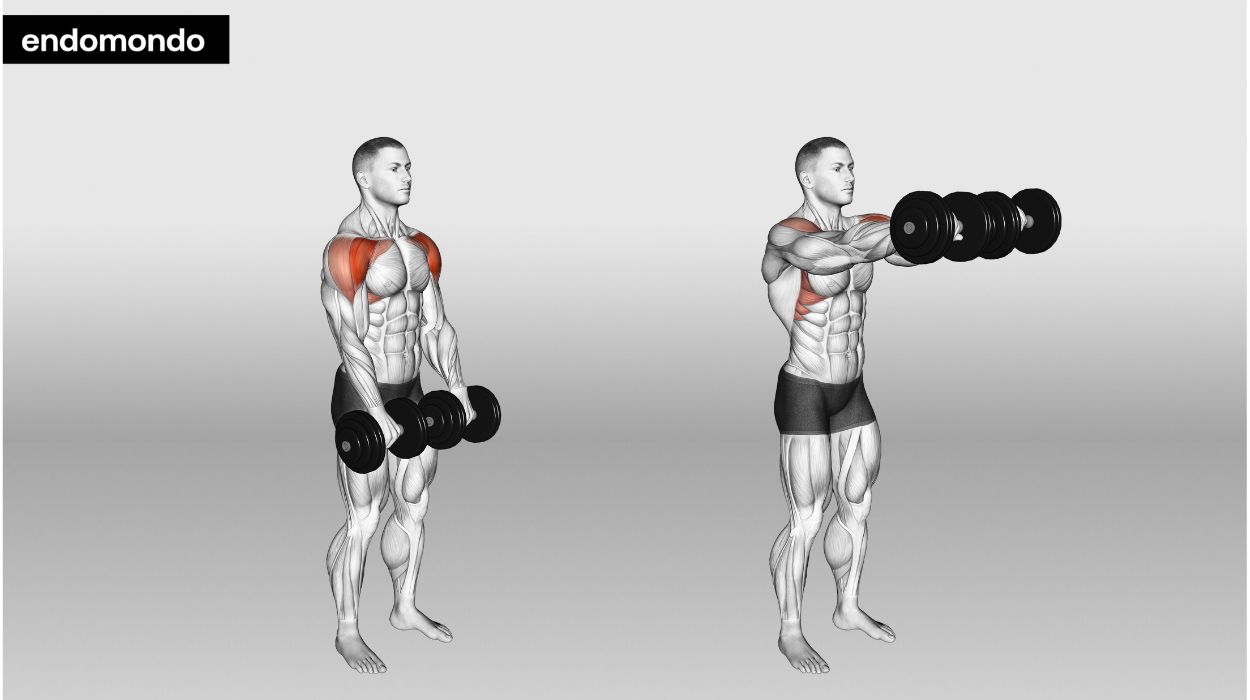
How to do:
- Keeping your feet shoulder-width apart, let the dumbbells hang in front of you with your palms facing your thighs.
- Lift the dumbbells in front of you and keep your arms extended.
- Continue until your arms are parallel to the ground or slightly below.
- Lower the dumbbells back down carefully to the starting position.
Tips:
- In the starting position, ensure your shoulders are relaxed and engage your core.
- Avoid lifting your arms above shoulder height to prevent overstraining your muscles.
Optimal sets and reps: 3-4 sets of 10-12 reps.
Bench Dumbbell Arnold Press
This exercise gained popularity from iconic bodybuilder Arnold Schwarzenegger. To make this power move, follow these simple steps below.
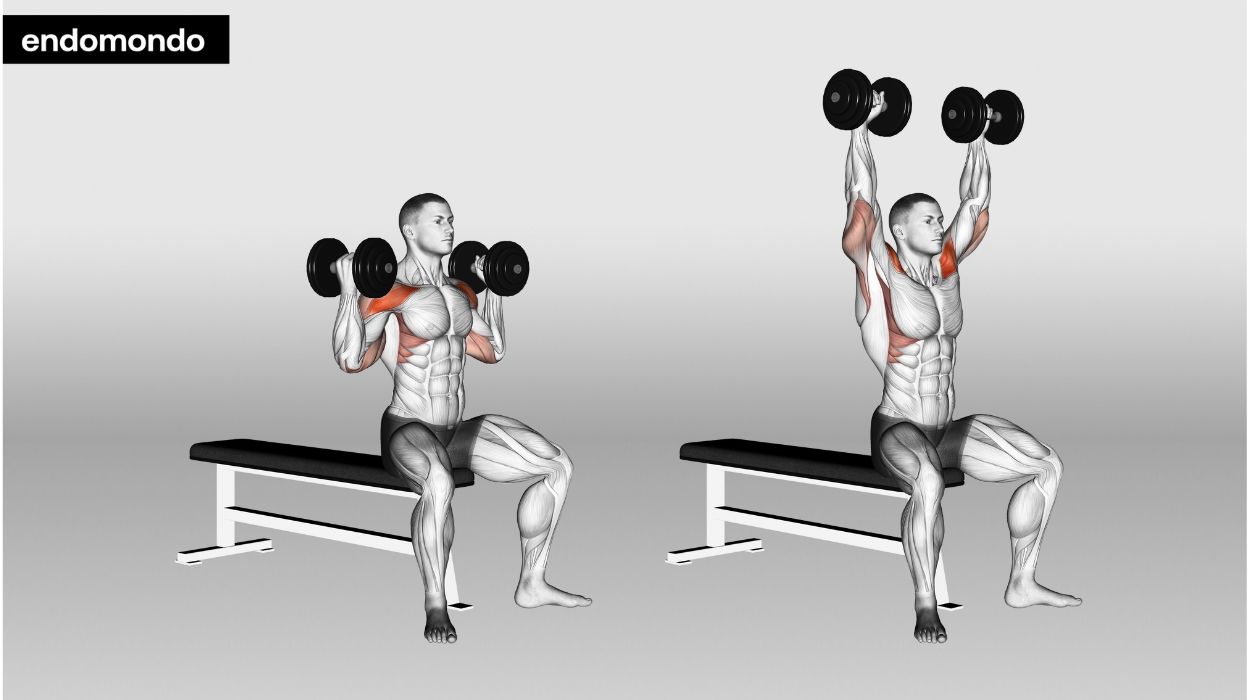
How to do:
- Sit on a bench and keep your feet shoulder-width apart. Begin with your palms facing your shoulders. Keep your elbows bent, creating a 90-degree angle.
- Rotate your palms to face forward as you push upwards with the dumbbells.
- Straighten your arms and press the dumbbells above your head.
- Rotate your palms back to your shoulders as you lower the dumbbells.
Tips:
- Avoid arching your back, and for stability, engage your core.
- Avoid locking your elbows as you push the weight above you.
- Make sure to start each rep at a 90-degree angle to keep tension on the muscles.
Optimal sets and reps: 3 sets of 10-12 reps.
Standing Kettlebell Single Arm Press
A kettlebell rather than heavier weights is a great way to switch things up at the gym while still targeting your shoulder muscles. Follow these steps to do this exercise on your next upper body day.
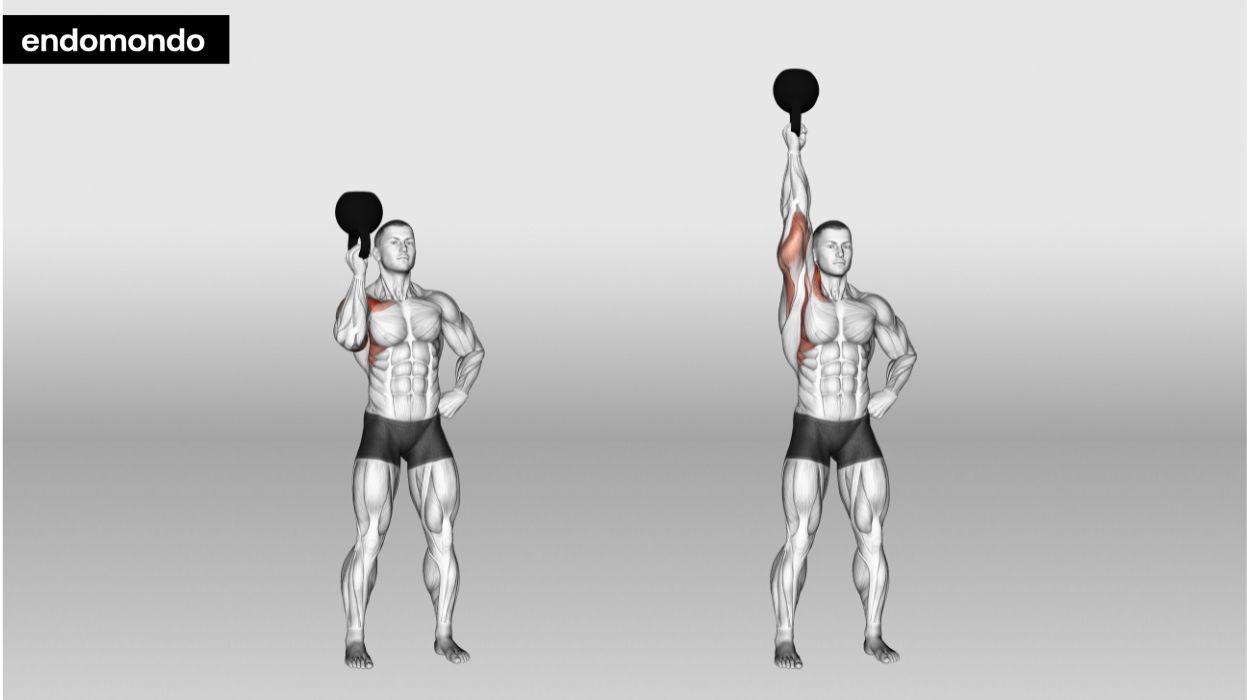
How to do:
- Hold the kettlebell in one hand and position it so it’s at shoulder height, palm facing upward.
- Press the kettlebell overhead by extending your arm fully. Keep your elbow close to your body as you lift your arm, engaging your shoulder muscles.
- Slowly lower the dumbbell back to the starting position.
Tips:
- Tighten your core muscles to stabilize your core.
- Maintain a neutral spine with a slight bend in your knees.
- Keep your wrist in a neutral position to avoid over-extension while performing this exercise.
Optimal sets and reps: 3-4 sets of 10-12 reps.
Standing Dumbbell Shrug
This isolation exercise targets your trapezius muscles, which run along the upper part of your back and neck. Here are the steps to do this exercise effectively.
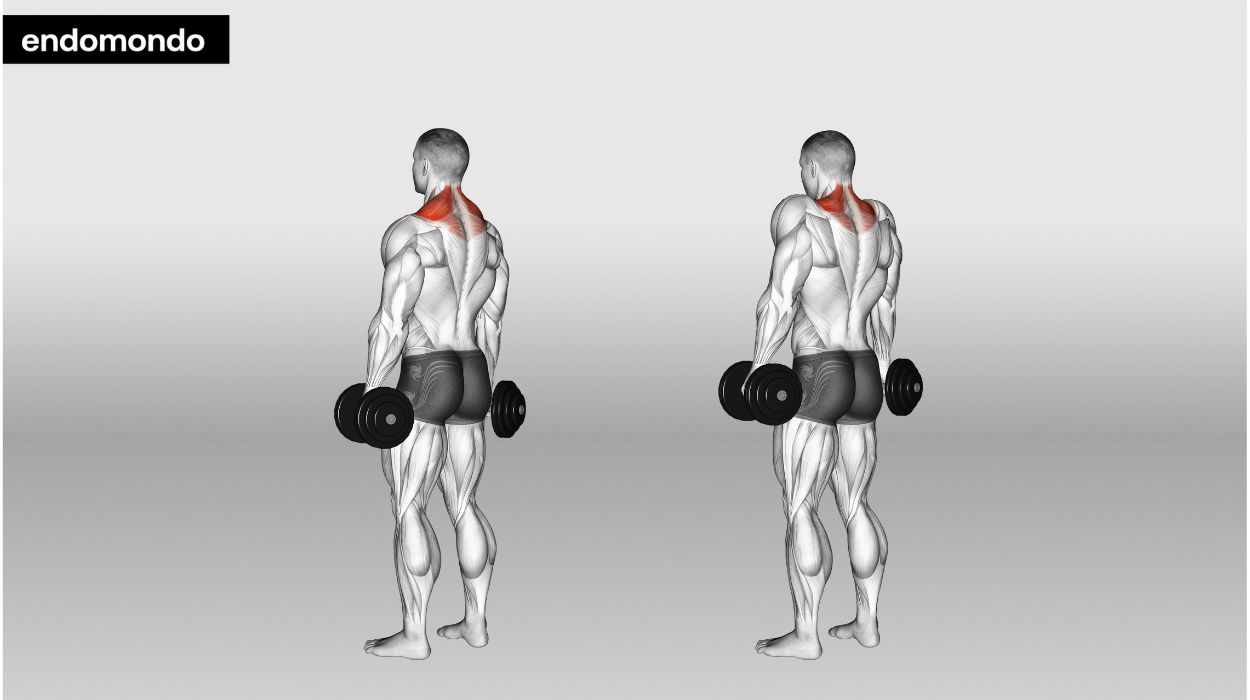
How to do:
- Hold a dumbbell in each hand by your side. Keep your arms extended, and make sure to stand with your feet shoulder-width apart.
- Start to bring your shoulders up to your ears in a controlled motion.
- Hold this position at the top briefly to emphasize the muscle contraction.
- Slowly lower your shoulders back down, allowing your shoulders to completely relax.
Tips:
- Maintain a good posture to avoid unnecessary strain on the neck and back.
- Avoid rolling your shoulders forward or backward during the movement.
Optimal sets and reps: 3-4 sets of 10-12 reps.
Standing Dumbbell 3-Way Shoulder Raise
This shoulder exercise is one that really gets those muscles burning. You may need to avoid heavy weights to thwart shoulder injuries and opt for a lighter weight for this one. Check out the steps below for how to do it.
How to do:
- Hold a dumbbell in each hand by your sides with palms facing your thighs. Make sure to have a slight bend in your elbows.
- Lift both dumbbells in front of you until your arms are parallel to the ground.
- Then, move both arms outward, keeping them parallel to the ground.
- Lastly, lower the dumbbells back to the starting position and repeat.
Tips:
- Make sure to keep a slight bend in your elbows the entire time.
- Choose a lighter weight that allows you to finish the entire sequence to enhance your range of motion. It’s better to focus on muscle engagement rather than heavy lifting for this exercise.
Optimal sets and reps: 3 sets of 12-14 reps.
Anatomy Of Shoulder Muscles
The shoulder is a complex joint containing many different muscles working together to provide a wide range of motion. The primary muscles of the shoulder include the deltoids, rotator cuff muscles, and various supporting muscles.[1]
Here’s an overview of these muscle groups:
Deltoid Muscles
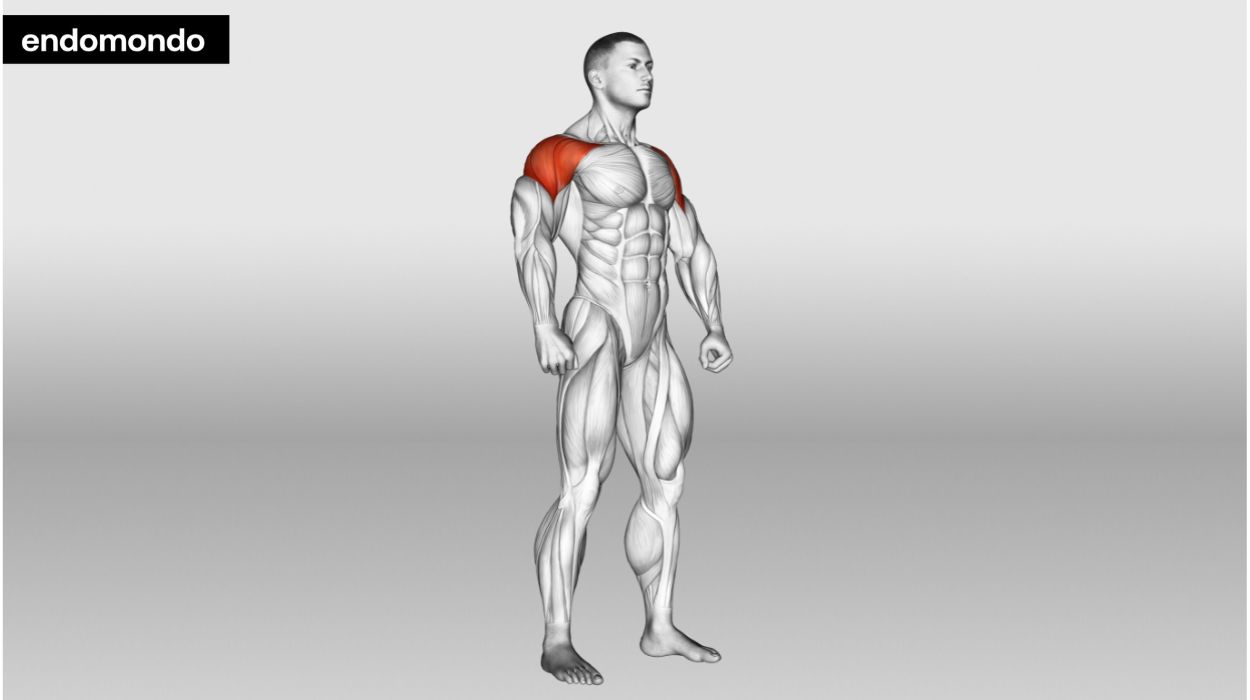
The deltoids are the major muscles of the shoulder and are responsible for the overall shape and appearance of the shoulder. The three parts of the deltoid muscle include the anterior, lateral, and poster deltoid.
Your anterior deltoid is what allows you to flex your arm, whereas your lateral deltoid allows you to lift your arm to the side — also known as abduction. The posterior deltoid helps extend and rotate your arm.
Rotator Cuff Muscles
The rotator cuff is a group of four small muscles that help stabilize the shoulder joint and allow for precise movements. These are the four small muscles: supraspinatus, infraspinatus, teres minor, and subscapularis. To not go too into detail, just think of these as the small muscles that help with the rotation and abduction of your arms.
Trapezius
The trapezius is a large muscle that spans the upper back and neck. This muscle deals primarily with your shoulder blades. When contracted, it allows you to squeeze your shoulder blades together and move them up or down —enhancing shoulder stability.
Rhomboid Muscles
You can find these muscles between your shoulder blades. These muscles help with retracting and shoulder stability.
Latissimus Dorsi
This muscle is commonly referred to as your “lats.” This is a very large muscle group of muscles of the back. These muscles extend from your lower to upper back and help move your shoulder joints.
Pectoralis Major
This large chest muscle contributes to shoulder movement more uniquely. It helps in activities that involve pushing against a force. Try pushing against a wall to feel this muscle contract.
Benefits Of Shoulder Exercises
A common complaint of aging is shoulder pain, specifically difficulties in raising the arm above the head. This can interfere with daily activities like getting dressed or doing household chores.
Research shows performing shoulder exercises[2] is the best way to combat this. A study showed that shoulder exercise participants had decreased pain, improved shoulder movement, and increased shoulder function.
Exercise therapy was shown to be just as effective as receiving steroid injections for shoulder pain. Additionally, complete shoulder training contributes to your general health by keeping you active, which can help improve your overall quality of life.
Tips For Shoulder Training
Training the shoulders effectively requires a balanced approach to target all aspects of this complex joint. As training progresses and fitness improves, you can try heavy weights instead of light ones where weights are used.
Here are some tips for effective shoulder training:
Don’t Skip Warming Up
A proper warm-up can help stretch your muscles before weight lifting. Some examples of shoulder warm-ups include arm circles and shoulder rolls that can help prep your shoulder muscles. Warm-ups get your blood circulating and help prevent injuries from stretching a tight muscle.
Prioritize Form
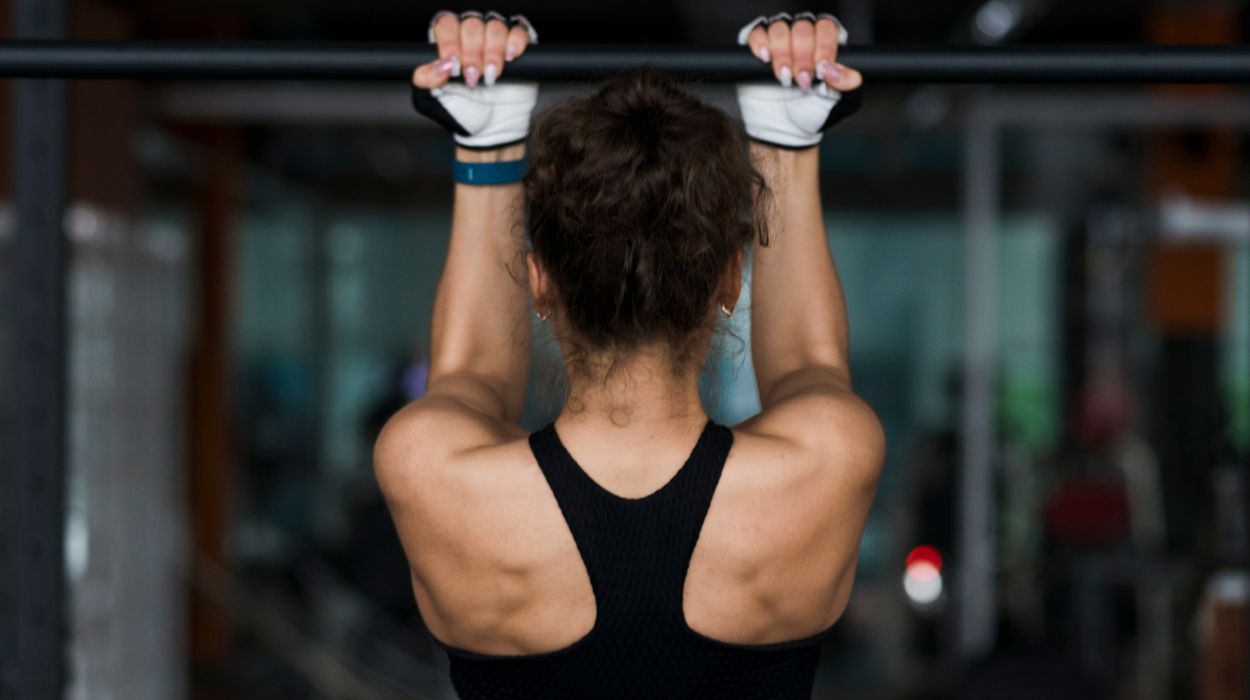
There’s nothing worse than causing injury through working out. Making sure you have proper form and technique can help decrease your risk of injury and ensure you’re targeting the shoulder muscles effectively.
Controlled Movements & Progressive Overload
Don’t rush through the exercises.
As your strength improves, gradually increase your weight. This increase allows you to keep challenging yourself and decreases the risk of injury.
Include Compound & Isolation Exercises
Combine compound movements like the Overhead Press or Push Press with isolation exercises like Lateral Raises and Front Raises. Doing this ensures that you’re targeting all of the shoulder muscles, not just one area.
Rest & Recovery
Allow time for rest and recovery between shoulder workouts. Training too much can lead to fatigue and increase the risk of injury.
It’s also important to listen to your body for any signs of pain that are beyond typical muscle fatigue while performing shoulder exercises. Don’t ignore this, as it could result in serious injury. If this occurs, avoid the exercise and reach out to a professional.
Conclusion
Your shoulder is a complex joint that contains many different muscles. Training your shoulders requires a comprehensive approach so you can target all of the main muscles and get the most out of your workout. The main muscle groups of the shoulders include the following: deltoid, rotator cuff, trapezus, rhomboid, latissmus dorsi, and pectoralis major; multiple muscle groups are worked in compound shoulder exercises.
All of these muscles work together to provide your shoulder with optimal movement and mobility. Benefits of engaging in shoulder exercises include improved mobility, decreased risk of injury, and decreased pain related to inactivity of the shoulder joint. All of which can contribute to a better quality of life.
It’s important to prioritize rest when training your shoulder muscles and reach out to a professional if you notice intense pain while performing a particular exercise. This can help prevent serious or long-term shoulder injuries. Other things like correct posture and controlled movements can help you get the most out of your shoulder strength training workout.
We shared 12 great shoulder exercises you can implement to stay healthy through physical activity without enduring shoulder injuries. If you’re new to this type of exercise, you can always find a personal trainer to help you with form and technique.
Frequently Asked Questions
A workout that targets all of the main muscle groups of the shoulder is preferred. This will help you get the most out of your workout.
It’s recommended to train the upper body 2-3 times weekly[3] for best results.
There is limited evidence about an exercise that is the best for the entire shoulder. However, one study found overhead presses and lateral raises[4] to be the best options when targeting the deltoid muscles of the shoulder.
While there is limited evidence on muscle growth for the shoulders without weights, bodyweight exercises can help improve overall strength[5] rather than muscle mass.
Resources
- McCausland, C., Sawyer, E., Eovaldi, B.J. and Varacallo, M. (2020). Anatomy, Shoulder and Upper Limb, Shoulder Muscles. [online] PubMed. Available at: https://www.ncbi.nlm.nih.gov/books/NBK534836/#:~:text=Muscles-.
- Painful Shoulder: Exercise Can Reduce Pain and Improve Mobility and Function. (2020). Journal of Orthopaedic & Sports Physical Therapy, 50(3), pp.142–142. doi:https://doi.org/10.2519/jospt.2020.0501.
- Jung, R., Gehlert, S., Geisler, S., Isenmann, E., Eyre, J. and Zinner, C. (2023). Muscle strength gains per week are higher in the lower-body than the upper-body in resistance training experienced healthy young women—A systematic review with meta-analysis. PLOS ONE, 18(4), p.e0284216. doi:https://doi.org/10.1371/journal.pone.0284216.
- Campos, Y.A.C., Vianna, J.M., Guimarães, M.P., Oliveira, J.L.D., Hernández-Mosqueira, C., da Silva, S.F. and Marchetti, P.H. (2020). Different Shoulder Exercises Affect the Activation of Deltoid Portions in Resistance-Trained Individuals. Journal of Human Kinetics, 75(1), pp.5–14. doi:https://doi.org/10.2478/hukin-2020-0033.
- Lipecki, K. and Rutowicz, B. (2015). The Impact Of Ten Weeks Of Bodyweight Training On The Level Of Physical Fitness And Selected Parameters Of Body Composition In Women Aged 21-23 Years. Polish Journal of Sport and Tourism, 22(2), pp.64–68. doi:https://doi.org/10.1515/pjst-2015-0014.




